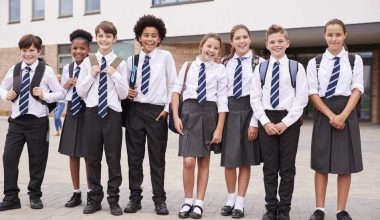High school is a time of self-discovery, academic rigor, and social interactions. Throughout the years, high school has become the backdrop for many movies, TV shows, and books, which have created a particular image of high school and its stereotypes.
While some high school tropes and stereotypes may seem exaggerated or far-fetched, certain aspects are surprisingly accurate.
Whether you are a high school student, a parent, or simply curious about the realities of high school life, this article will shed some light on the truths behind the high school experience.

Table of contents
- What Is A High School Stereotype?
- Ten high school stereotypes and Tropes that are true
- How do these stereotypes and tropes impact high school students?
- Is there any research to support the validity of these stereotypes and tropes?
- Are there any steps that can be taken to challenge or break down these stereotypes and tropes in high schools?
- How can individuals navigate the social hierarchy and cliques in high school?
- Do these stereotypes and tropes vary across different cultures or geographic regions?
- Frequently Asked Questions
- Conclusion
- References
- Recommendations
What Is A High School Stereotype?
A high school stereotype is a generalization or preconceived notion about students or their behavior. These stereotypes can be based on social status, academic ability, or personal interests and may be perpetuated by media, social norms, or personal experiences.
While some high school stereotypes may hold some truth, they do not define every individual’s high school experience. It is essential to approach these stereotypes with an open mind and a willingness to see beyond them.
Read also: What is MyMathLab?
Ten high school stereotypes and Tropes that are true
#1. Jocks
The stereotype of jocks being popular and athletic is often true in high school. Sports teams can be a big part of the school culture, and athletes may receive more attention and social status.
#2. Mean girls
High school girls may form cliques and be selective about who they associate with, leading to a “mean girls” stereotype. This can create a sense of exclusion for those not in the clique.
#3. Nerds
The stereotype of nerds being academically focused and socially isolated is often true in high school. High academic achievement may be associated with a lack of social skills or popularity.
See also: How Many Weeks Are in A Typical School Year in 2023?
#4. Drama geeks
Drama or theater students may be seen as eccentric or “dramatic,” and may form close-knit groups with others who share their passion.
#5. Stoners
Some high school students may experiment with drugs or marijuana, leading to a “stoner” stereotype. This can impact their academic performance and social life.
See this related content: Top Tips on How To Find The Right Student Accommodation in the UK.
#6. Bullying
High school can be difficult for some students who may be bullied or ostracized by their peers. Bullying can have serious long-term consequences for mental health.
#7. Senioritis
Many seniors experience decreased motivation and effort as they approach the end of high school, known as senioritis. This can impact their academic performance and preparation for college.
See this related content: What Does A Deputy District Attorney Do In 2023? Full Guide.
#8. Cliques
High school students may form cliques based on shared interests or backgrounds, leading to a social hierarchy and exclusion of those not in the group.
#9. Cheerleaders
Cheerleading can be a popular extracurricular activity in high school, and cheerleaders may be seen as attractive and popular.
#10. AP students
High-achieving students who take advanced placement (AP) courses may be seen as “nerdy” or socially isolated but may also be respected for their academic success.
It’s important to note that these stereotypes are not valid for everyone and can vary depending on the individual high school experience.
See also: How to Write a Winning Application Essay for an Art School in Los Angeles.
How do these stereotypes and tropes impact high school students?
Stereotypes and tropes in high school can impact students in several ways.
Firstly, they can pressure students to conform to certain expectations or behaviors to fit in or gain social status. This can lead to anxiety, isolation, or inadequacy for those who don’t fit into these stereotypes or don’t want to conform to them.
Secondly, stereotypes and tropes can reinforce social hierarchies and cliques, leading to the exclusion and bullying of those seen as different or outside of the norm. This can create a hostile and unwelcoming environment for some students.
Thirdly, these stereotypes can impact academic achievement, as students labeled as “nerds” or “geeks” may be discouraged from participating in extracurricular activities or socializing with peers. This can impact their motivation and sense of belonging in the school community.
Finally, stereotypes can also impact mental health, as students who are bullied or ostracized may experience depression, anxiety, and other adverse emotional effects.
While some stereotypes may hold some truth, it is essential to approach individuals with an open mind and not make assumptions about their behavior or character based on these labels.
Read also: What Are The Different Types of Academic Qualifications in 2023?
Is there any research to support the validity of these stereotypes and tropes?
Some research supports the validity of high school stereotypes and tropes. However, it is essential to note that not all individuals fit into these labels, and experiences may vary depending on the school and the individual.
For example, a study published in the journal Youth & Society found that students who were part of athletic teams in high school tended to have higher social status and were more likely to be friends with other famous students. Another study published in the Journal of Educational Psychology found that students labeled “nerds” or “geeks” tended to have lower self-esteem and were less likely to participate in extracurricular activities or socialize with their peers.
Research has also shown that high school cliques and social hierarchies are typical, with students forming exclusive groups based on shared interests or social status. A study published in the journal Child Development found that social exclusion by peers in high school can have negative long-term consequences for mental health and social relationships.
However, it is essential to approach these findings cautiously, as stereotypes and tropes can vary depending on the school and the individual. It is also important not to make assumptions about individuals based on these labels, as they can be limiting and unfair.
See this related content: Top 20 Universities in Warwickshire in 2023
Are there any steps that can be taken to challenge or break down these stereotypes and tropes in high schools?
Yes, several steps can be taken to challenge or break down stereotypes and tropes in high schools:
Encourage diversity and inclusion.
Schools can promote diversity and inclusion by creating a welcoming environment that celebrates differences and encourages students to learn about and appreciate different cultures, backgrounds, and experiences.
Foster positive relationships
Schools can create opportunities for students to develop positive relationships with their peers and teachers, which can help to break down social barriers and promote a sense of belonging.
See also: 15 Best Universities in the UK for Politics | 2023
Challenge negative behaviors
Schools can address negative behaviors such as bullying, exclusion, and discrimination by implementing anti-bullying policies, providing resources for students who are victims of bullying, and promoting empathy and respect for others.
Provide positive role models.
Schools can provide positive role models for students by highlighting individuals who have achieved success outside traditional stereotypes or tropes, such as successful artists or scientists who were once labeled “nerds.”
Read also: What is Hotel Steward? All You Need to Know in 2023
Promote extracurricular activities
Schools can promote various extracurricular activities that appeal to different interests and talents, which can help break down stereotypes and cliques and promote a sense of community and inclusion.
Breaking down stereotypes and tropes in high schools requires a concerted effort from teachers, administrators, and students alike. Schools can create a more positive and inclusive environment that benefits all students by promoting diversity, empathy, and respect.
See also: Best Law Universities in London.
Navigating the social hierarchy and cliques in high school can be challenging, but there are several strategies that individuals can use to make the experience more manageable:
Find a supportive group.
Finding a group of like-minded individuals with similar interests and values can be helpful. This provides a sense of belonging and support, which helps mitigate the adverse effects of cliques and social hierarchies.
Focus on personal growth.
Instead of worrying about fitting into a particular stereotype or clique, individuals can focus on personal growth and development. This can include exploring new interests, setting goals, and pursuing academic or extracurricular activities that are personally fulfilling.
Seek out diverse perspectives.
It is helpful to seek diverse perspectives and opinions, which can challenge assumptions and break stereotypes. This can include reading books, watching films, and participating in activities that expose individuals to different cultures and experiences.
Read also: How Do I Become a Quantum Physicist in 2023? Step-By-Step Guide.
Practice empathy and respect.
Individuals can also practice empathy and respect towards others, even those who may be different or outside their social group. This can promote a more inclusive and accepting environment.
Talk to a trusted adult.
If navigating the social hierarchy and cliques becomes overwhelming or distressing, talking to a trusted adult, such as a teacher, counselor, or parent, can be helpful. They can provide support and guidance on how to cope with the challenges of high school social dynamics.
Read also: What is MyMathLab?
Do these stereotypes and tropes vary across different cultures or geographic regions?
Yes. Stereotypes and tropes can vary across different cultures and geographic regions. While some stereotypes may be universal, others may be specific to particular cultural or geographic contexts.
For example, academic achievement and success are highly valued in some cultures, and students who excel academically may be seen as popular or well-respected. In other cultures, sports and athleticism may be more highly valued, and athletes may have higher social status and popularity.
Similarly, social hierarchies and cliques can vary depending on the cultural and geographic context. For example, in some cultures, the social status may be determined by family background or wealth, while in others, it may be determined by factors such as appearance, fashion, or music preferences.
It is essential to recognize that stereotypes and tropes can be limiting and unfair and that they can contribute to discrimination and prejudice. By promoting diversity, empathy, and respect, we can challenge and break down stereotypes and create more inclusive and accepting environments.
See also: How Many Weeks Are in A Typical School Year in 2023?
Frequently Asked Questions
No, every high school experience is unique, and while some stereotypes may be more prevalent in certain schools, they do not define every individual’s experience.
Not necessarily. While popularity may play a role in the social hierarchy, factors such as academic achievement, athletic ability, and personal interests can also impact an individual’s social status.
While cliques can create a sense of exclusivity and make it difficult for some students to feel included, they can also provide a sense of community and belong for individuals who share similar interests and values.
Senioritis is a natural phenomenon in which seniors experience decreased motivation and effort as they approach the end of their high school careers.
Understanding high school stereotypes and tropes can help individuals approach their own experiences with a more open mind and a deeper appreciation for the complexities of this formative time. Understanding these stereotypes can help parents and educators better support and guide high school students.
Conclusion
While high school stereotypes and tropes may seem like over-the-top exaggerations, many are grounded in truth. From the popular cliques to the struggles of senioritis, high school life can be exciting and challenging. It’s important to remember that while these stereotypes may hold some truth, they do not define every individual’s high school experience.
High school is a time of growth and exploration, and everyone’s journey is unique. By understanding the realities behind high school stereotypes, we can better appreciate the complexities of this formative time in our lives.
Whether you’re a current high school student, a parent, or simply looking back on your high school years, it’s essential to approach these tropes and stereotypes with an open mind and a willingness to see beyond them.
References
- helpfulprofessor.com– High school stereotypes
- lovepanky.com– High school stereotypes and Tropes
- thetoptens.com– High school stereotypes and Tropes
- betterhelp.com– High school stereotypes
Recommendations
- How to Write a Winning Application Essay for an Art School in Los AngelesWhat Does A Deputy District Attorney Do In 2023? Full Guide
- What Are The Different Types of Academic Qualifications in 2023?
- Top 20 Universities in Warwickshire in 2023
- 15 Best Universities in the UK for Politics | 2023
- What is Hotel Steward? All You Need to Know in 2023


